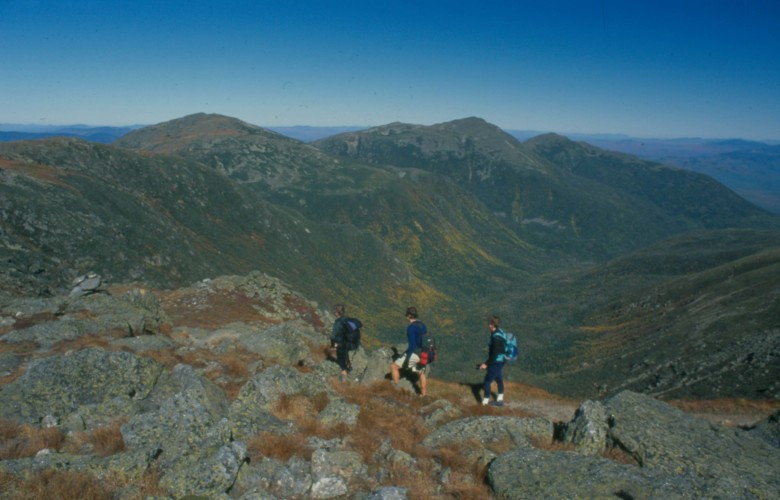Doing the Presidential Traverse Hike in New Hampshire’s White Mountains | Tips
New Hampshire’s White Mountains Presidential Traverse hike is one of New England’s premier outdoor activities. Here’s how to do it.

Hikers ascend Mt. Adams in the northern Presidential Range of New Hampshire’s White Mountains. The AMC’s Madison Spring Hut is in the background.
Photo Credit : Dennis Walsh, AMCTips for Doing the Presidential Traverse Hike | White Mountains
So what does it take to do the Presidential Traverse hike? To find out, we caught up with AMC hiking guide Bill Quade, who’s hiked the Presidential Traverse several times and who leads guided trips of the range.Preparing for the Presidential Traverse Hike
Quade says hikers need to be ready for the physical demands of the Presidential Traverse hike. After all, this trek accounts for nearly 9,000 total feet in elevation gain. “You should plan on moving about a mile an hour,” he says. “So before anybody tries a Presidential Traverse, they should test their legs and either hike a segment of it or try another part of the Whites.” One area that Quade recommends visitors consider when getting ready for the Presidential Traverse hike is the Franconia Ridge Loop. This nine-mile trek brings hikers over Mount Lincoln, Mount Lafayette, and Little Haystack, offering the same kinds of challenges (weather and, to a certain extent, physical demands) of the Presidential Traverse hike. “It’s a beautiful hike,” says Quade. Monitoring temperatures and conditions is a must for the Presidential Traverse hike. Weather systems change all the time, and the forecast for, say, downtown North Conway, or even the trail below the tree line, may be much different from what’s being predicted for the alpine zones. To get the most accurate weather forecasts, Quade advises, monitor the forecasts from the Mount Washington Observatory. “But even if the weather does look good, allow yourself to be flexible,” he says. “Don’t be afraid to bail if you see bad weather moving in suddenly. Monitor the skies and get below the tree line if you see thunderheads move in.”Where & When to Do the Presidential Traverse Hike
Hikers have two options for a starting point: the northern terminus, at the base of Mount Madison, and the southern terminus, beginning at the Highland Center at Crawford Notch. The northern half, which includes the peaks of Madison, Adams, Jefferson, and Washington, is recognized as the hardest part of the trail, and Quade recommends beginning there. “That way, you can hike that harder stretch when your legs are at their freshest,” he says. Experienced hikers can and will do the Presidential Traverse hike in every season, but Quade says that most people stick to the summer months, when there’s maximum daylight. “July and August are very nice,” he says. “June offers more likelihood of thunder and lightning storms, and when you get into September the weather can turn cold. In October you can even hit ice.” For safety reasons, Quade suggests that you do the Presidential Traverse hike with at least one other person. While it can be done in a single long day, he recommends that it be tackled over the course of two or more days. Hikers can either camp off-trail below the tree line or book a bed at one of the three AMC huts in the range: Madison Spring, Lakes in the Clouds, and Mizpah Spring. Even for those without reservations, these huts offer a nice respite. During the day, the staff sells soup, baked goods, and lemonade to hikers; water bottles can also be refilled free of charge.
Photo Credit : Josh Lake/Courtesy of AMC
Gearing Up for the Presidential Traverse Hike
What you bring can all make all the difference in terms of whether you finish and how you finish. For summer trekkers, Quade says, a backpack should include the following:- Rain pants and rain jacket
- Winter hat and gloves
- Sun protection
- Whistle
- Compass
- Map
- First aid kit
- Trekking poles
- Headlamp
Also…
Be sure your mobile phone is fully charged and turned to airplane mode when you start hiking. Cell reception is spotty, and if your phone is searching for a signal for a long amount of time, the battery will run down. Stay on the trail. The alpine zone (the region above the tree line) is chock-full of tender moss and grasses, and hiker who straying off course can easily trample and kill this vegetation. Finally, know that there is the option for a guided hike of the Presidential Traverse. The Highland Center offers expert-led trips through the range with stays at an AMC hut. There is a southern segment that runs two days and one night, and a complete traverse spanning four days and three nights. Trips are led only in summer and slots fill up quickly, so reserve early in the season. Call the Highland Center for details and pricing. Have you done the Presidential Traverse hike? Share your experience in the comments! This post was first published in 2017 and has been updated.SEE MORE:
Franconia Ridge Loop | The Perfect White Mountains Hike
Favorite Late Fall Hikes in New England
The Flume Gorge | Hiking Through History
Ian Aldrich
Ian Aldrich is the Senior Features Editor at Yankee magazine, where he has worked for more for nearly two decades. As the magazine’s staff feature writer, he writes stories that delve deep into issues facing communities throughout New England. In 2019 he received gold in the reporting category at the annual City-Regional Magazine conference for his story on New England’s opioid crisis. Ian’s work has been recognized by both the Best American Sports and Best American Travel Writing anthologies. He lives with his family in Dublin, New Hampshire.
More by Ian Aldrich

